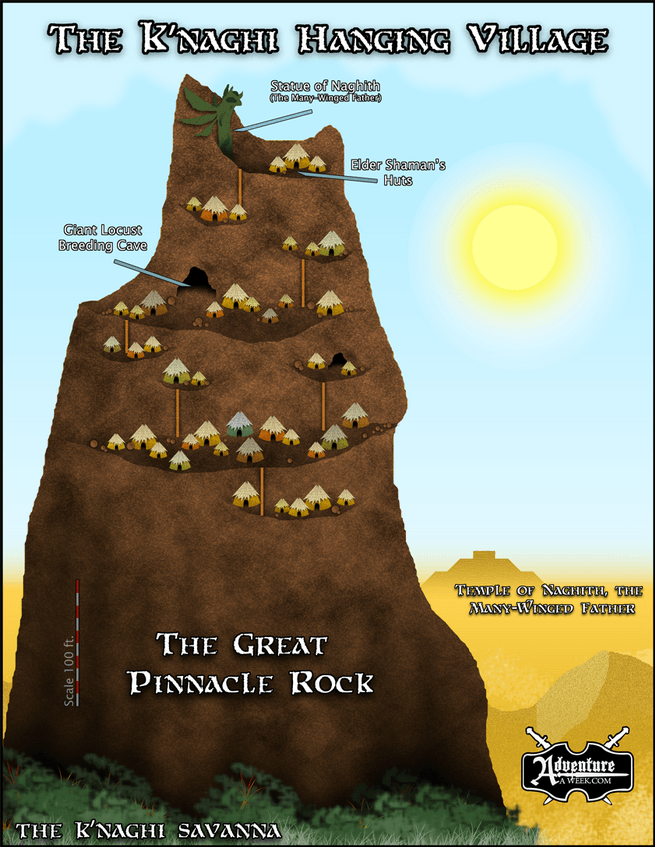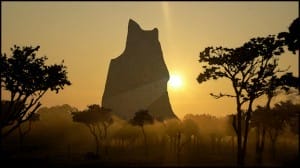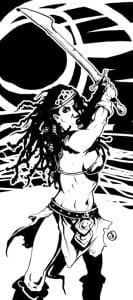 The K’naghi Savanna
The K’naghi Savanna
Located on the northern edges of the Alimpulosa, the savanna surrounds the region’s most notable landmark—the Pinnacle Stone. An unusual oasis of life in the midst of an otherwise harsh desert, the savanna covers barely a square mile in surface area and its borders are very nearly circular shaped with the great peak at the center. A sea of sand and dunes expands beyond the border of the K’naghi savanna, named for the tribe of humans who dwell within.
The Savanna is a magical place, sustained by the effects of the song of ancestors, which replenishes the flora and fauna within every morning. Various grasses and acacia trees—as well as a myriad of other plant-life, small animals and an abundance of locusts which feed on the dry grasses—provide ample resources for the K’naghi people.
The Pinnacle Stone
The tallest natural feature in the region, the Pinnacle Stone is a narrow-sided butte that rises an astonishing three hundred feet into the air. The sheer sides are next to impossible to climb; however, the K’naghi tribesmen maintain their village on the few outcroppings near its peak, using giant locust mounts to fly up to their homes. The Pinnacle Stone is widely used for navigation through the badlands, as its high enough to remain visible for many, many miles beyond the immediate region.

The Hanging Village
The village is home to the K’naghi tribe, located upon several stone outcroppings near the peak of the towering Pinnacle Stone. Dozens of huts using the mud and dry grasses from below are connected by a network of ladders that reach from one outcropping to the next. The peak is also bestowed with a series of narrow caves, tunnels, and caverns which the K’naghi people use to navigate from various sections of the village. It is typically high enough to remain safe from the region’s frequent sandstorms, however when a particularly forceful desert gale threatens their people, the K’naghi retreat to the safety of the caverns that pockmark the peak of the Pinnacle Stone—to the tribe’s leader and elder shaman, and a massive stone statue of Naghith, their tribal god.
The K’naghi Tribe
Indigenous to a region bordering theAlimpulosa, the K’naghi people are a tribe of humans renowned for their practice of flying on the backs of giant locusts. They inhabit the tiny savannah region that encircles the great Pinnacle Stone, making their home upon the peak of the towering landmark. The tribe subsists mainly off of the resources of the savannah below their village, gathering water from beneath the bark of the many acacia trees, crafting their homes, clothes, and wares from intricate weaving of the dry grasses. Their staple diet consists of locusts, barriers, and roots, of which the K’naghi Savanna provides in plenty. However, they are also known to trade from time to time with various tribes through the region—in particular the Ayaxan gypsies, who find the lightweight yet durable garments crafted by the K’naghi perfect for their desert travels.
The tribe speaks an unusual mix of broken Common and Giant, which can be loosely understood by anyone that speaks either of the languages. The mythology of the K’naghi teaches that eons ago, their people were the slaves of great desert-dwelling giants until the great hero Anapo organized a bloody revolt. Devoted to their god Naghith, the K’naghi believe he slumbers in a temple visible in the distance from the peak of the Pinnacle Stone.
 Naghith, the Many-Winged Father
Naghith, the Many-Winged Father
Naghith is the tribal god of the K’naghi people. He is depicted as a humanoid with three pairs of insect-
like wings, and rounded insectile eyes.
The mythology of the K’naghi people tells of an ancient time, when Naghith arose from the temple complex and freed their people from the enslavement of tyrannical giants. Legend tells that the god was awakened by the prayers made at the foot of the ancient temple by two human slaves—Anapo, a teenage boy, and the witch Banhi, his older sister.
A fierce and violent god, Naghith, surrounded by swarms of giant locusts, laid waste to the giant captors of the tribe. During the onslaught, Anapo bravely mounted one of the giant locusts and rode upon its back in an assault against the leader of his giant overlords, killing it with a spear strike through its throat.
Seeing the courage of their brother, the other slaves followed Anapo’s lead and mounted the giant locusts swarming about the encampment, attacking their brutal masters. When it was over, not a single one of the giants remained living; freed from their enslavement, the humans praised the great locust god whom had come to their aid.
Weary from the battle, the Many-winged Father returned to his slumber within the temple, leaving the K’naghi (and their locust mounts) to their newfound freedom. As the battle-weakened god returned to the confines of his temple, some of the tribesmen wondered at the motives of their new patron; if their savior ever rose again, it could likely mean their own destruction.
The hero Anapo was quickly elected as the tribal leader, and he decided that his people, using their locusts as transportation, would take refuge upon the distant towering peak, where they would forever remain out of the reach of giants. Banhi was charged by her kinsmen with the duty of assuring that the slumber of Naghith remained undisturbed. Using her great magic, she summoned forth the life-force scattered and strewn about the badlands, and created the savanna that today surrounds the Pinnacle Stone, promising that this land would always provide for their tribe. In return, the spirits of the tribe would forever remain at the great stone, assuring their continued survival by softly singing to the slumbering god in the distant temple. The name “K’naghi” translates to Common from Giant to mean, “Watchers of Naghith.”
Eventually Anapo and Banhi joined the whispering spirits of the K’nahgi, but through their lineage was founded a tribal dynasty of shaman—warrior witches destined to watch over the K’naghi. Banthadar—the current elder shaman of the tribe—is the sixth descendant of Anapo and Banhi, and continues the traditions they founded more than three centuries ago.
 Banhi’s Final Prophecy
Banhi’s Final Prophecy
Long after the death of the hero Anapo, the great witch-mother lay aged, grayed, and wrinkled upon her deathbed. It was as she neared her final breaths, before joining the hero’s spirit in the K’naghi savannah, that she had a powerful vision. What she experienced was powerful enough to cause her to arise from her incapacitated state and climb—alone—to the highest point of the Pinnacle Stone, to shout down to her people below:
I am Banhi, sister of the great hero Anapo, mother protector to the K’naghi, and curator of our people’s spirits. I go now to join my kin in his song, but I leave this final gift to my children and my children’s children—don’t forget it! When the day becomes night and the sky summons the locust star, the awakening of the Many-Winged Father shall be near forget—our songs cannot forever lull his slumber! When these things come to pass, new heroes shall arrive to your aid. Heroes who, like Anapo, courageously face a new enemy of our people. These outsiders will learn to command the sky and it will be they who send Naghith to his final slumber, freeing you, the watchers and whisperers, from our unending duty. Until that day, my children: live, love, watch, and sing.
This oral prophecy is memorized word-for-word in youth by every member of the K’naghi tribe as a reminder of their inherited duty and what their future may hold. Moments after speaking the words upon the height of the peak, it is said that Banhi dove over the sheer side of the cliff and plummeted to her death, thus adding her voice to the whispers of the song of the ancestors.

